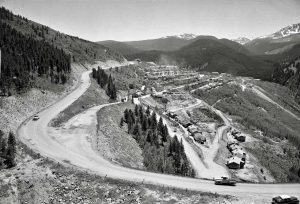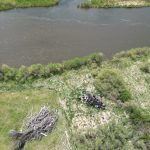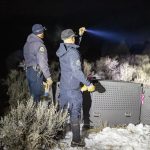Beaver problems
Eagle Valley Enterprise
Vail, CO Colorado

ALL |
EAGLE, Colorado – There are two environmental situations clashing along Brush Creek in Eagle Ranch – beavers and pollution control.
Beavers are the root of the problem.
“We want to leave the beavers alone, but we also don’t want pollutants going into Brush Creek,” said Eagle Open Space Director John Staight. “This is a real problem, not just a nuisance.”
About a month ago, Eagle Public Works inspector John Boyd noticed some trees around the Eagle Ranch storm ponds that had been chewed on by beavers. He didn’t worry too much about it until they started damming up the hydraulic systems between the ponds a couple of weeks ago.
Some rather large trees were lost around that same time. One had to be cut down early one morning last week before it fell over the bike path. On that tree, beavers had whittled the trunk, which was about 15 inches in diameter, down to about 4 inches.

Support Local Journalism
“We had to take that down before a breeze knocked it over,” Boyd said.
Several damaged trees are still standing but will probably die.
The storm ponds are the main concern, however. They are a filtration system for water going back into Brush Creek from the Eagle Ranch development. By flowing from one pond to the next, pollutants such as fertilizers and petroleum are strained from the water before it goes into the creek.
“The beavers had raised the water level of the ponds a little more than a foot over the weekend,” Boyd said last week. “I noticed that some sticks and debris from the bottom of the pond were piled over the grate (where water drained from one pond to the next).”
The beavers were damming the outlets of the last two ponds. The final pond is only separated from Brush Creek by a narrow berm.
“At that rate, it wouldn’t be long before the pond water washed out the berm and went straight into the creek,” Boyd said.
The final pond is very clean, but it wouldn’t be that way if the pond above it washed out, as well.
The first response was to trap and relocate the beavers. One large male was trapped and relocated two weeks ago, and last week, a smaller, younger one was trapped. The second was simply released on site.
Colorado Parks and Wildlife Officer Craig Wescoatt informed the town that it’s too late in the season to relocate the animals.
“I recommended that any trapped beavers be put down in a humane manner,” he said. “A relocated beaver would have trouble adapting to a new environment and would likely starve over the winter.”
The town’s new solution is to let the beavers remain and hope they go somewhere else in the spring.
“This isn’t the best habitat for them anyway,” Staight said. “We’re trying to make the area even less appealing to them for now. In the spring, when the water rises in Brush Creek, they’ll hopefully go downstream where there’s better habitat.”
The measures to make the area less beaver friendly include putting wire around trees and making a “beaver deceiver,” as Boyd called it. The beaver deceiver is intended to dissuade attempts to dam a pond outlet. It’s made of wire and T posts.
“The key is to make a trapezoidal shape,” Boyd said. “That way, they can’t make a linear dam across the outlet.”
The second-to-last pond has a drainage grate, the one Boyd first noticed blocked with debris. He simply circled wire around the grate to keep the animals from putting material over the top of it.
The other step being taken to discourage the animals is adding wire around trees. Some of the trees were planted when Eagle Ranch was built and already have chicken wire around them. Boyd recently placed thicker wire in a wider circumference around the plants, wrapping more than 30 trees.
All of the measures appear to be working. The dams on Brush Creek don’t pose much of a problem and will be left alone for now. Staight said they might even be washed out by the spring runoff.
Colonies can have seven or eight beavers and as many as 30, depending on the size of the habitat. Boyd thinks there might be half a dozen in the Eagle Ranch area.
A colony consists of a mating pair and a couple of generations of offspring. The offspring will live with the parents for a year or two, depending partly on how quickly the colony grows. Boyd and Staight think the Eagle Ranch beavers came from the colony downstream by the medical center.
“These beavers seem to be getting a late start, which might be why they chose this area in Eagle Ranch, which isn’t the best habitat for them,” Staight said.
Travis Barton grew up in the area and has been trapping beavers all over the county for a long time. He’s the guy people call up when the animals need to be removed. He said he’s trapped at least 30 beavers on Brush Creek alone through the years. It’s been a side job that pays him for each animal he catches.
His full-time job is managing a lumber yard in Summit County. He chuckled and acknowledged that his occupation with wood might give him something in common with his prey.
“In a year, every tree here would be lopped off if you didn’t do anything,” he said of the Eagle Ranch situation. “It’s hard to say how many beavers we have here but probably quite a few.”
Beavers are vegetarian. They eat wood and some plants such as cattails. For baiting traps, scent is more important than anything else.
“They don’t have great vision, but they have an acute sense of smell,” Boyd said.
The traps are baited with a musky scent.
After releasing the second beaver back to its Eagle Ranch lodge, Barton packed up his trap. He might not need to come back at all.
“Hopefully, we’ll only have to deal with the activity for the next couple months, before they hunker down for winter, and then we’ll re-evaluate in the spring,” Staight said.









